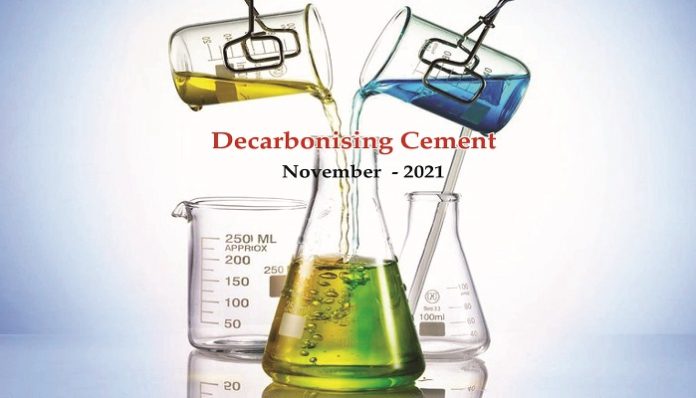Decarbonising of the cement industry is a challenging but pressing problem as the demand for concrete is expected to grow unabated. Release of carbon dioxide is intrinsic to the process of cement manufacture, yet concrete with its ability to absorb carbon dioxide can become a global carbon sink. This month’s column examines the many dimensions of the cement-concrete conundrum.
If the cement industry were a country, it would be the third largest emitter of carbon dioxide in the world after China and USA and above India. The cement industry’s contribution to global warming is 8 percent. But unlike many other sectors, the emission from the cement industry is intrinsic to the manufacturing process. 60 percent of the carbon dioxide emitted in cement industry is released during the calcination process; the remaining 40 percent is contributed by the use of fuel and electricity. Thus decarbonisation of cement industry is extremely difficult as it cannot be achieved through change of fuel or higher energy efficiency.
Cement is the primary constituent of concrete, the second most consumed material in the world next only to water. The per capita consumption of concrete is threetons per annum. Twice as much concrete is used in construction than all the other materials combined. With infrastructure in much of the developed world rapidly approaching the limit of their useful life and an insatiable appetite in the developing world, the demand for concrete and cement is likely to grow unabated in the foreseeable future.
Carbon dioxide is released in the cement industry during the production of clinker by calcination of limestone. Substitution of clinker partially or even eliminating it completely is emerging as the main strategy for decarbonisation of the cement manufacturing process. Carbon dioxide capture and storage is another alternative. Also important are recycling and reuse of concrete and reducing the usage of concrete through design.
Clinker Substitution
The key ingredient of cement is clinker. Clinker is produced by calcination of limestone, a process that releases large quantities of carbon dioxide. Clinker production is also the most energy-intensive part of the cement manufacturing process. Typically, the cement specification lays down a range for clinker concentration and most cement producers have traditionally been erring on the side of caution and including more clinker than necessary to meet the specification. Closer a cement plant can get to the lower end of the clinker concentration range, lower would be its operating costs and carbon footprint. The average global clinker to cement ratio is currently 0.81. The balance is made up of gypsum and Supplementary Cementitious Materials (SCM). Among the SCM widely used today are blast furnace slag, fly ash from coal-fired boilers, calcined clay and natural pozzolans. It is estimated that the average clinker to cement ratio will fall below 0.60 by 2030.
Concrete without Cement
Carbicrete, a Montreal-based company has developed a technology to make concrete without using cement. Instead of cement, the company uses waste slag from the steel industry plus carbon dioxide captured from other industrial plants. The technology can thus stake claim for negative emission. During the curing of traditional concrete with water, the calcium oxide in cement reacts with carbon dioxide in atmosphere to form strengthened calcium carbonate. In Carbicrete’s technology, carbon dioxide captured from other industrial processes is injected to react with the calcium oxide present in the waste slag from steel industry. Though having exactly the same chemical composition, Carbicrete claims that concrete made this way has 30 percen higher compressive strength than the traditional concrete. However, Carbicrete’s technology can only be used in the controlled environment of a factory to produce precast concrete panels that can be delivered to a construction site. It cannot be used for production of ready-mix for on-site curing of foundations at the construction sites. Also the process depends on a steady supply of steel slag, which is not enough to meet the global demand of concrete.
Carbon Capture
Concrete has the potential to become a global carbon sink. This will happen when carbon capture utilisation and storage (CCUS) technologies mature to a level, where more carbon dioxide is captured and stored in concrete than is generated during its production. Carbon dioxide from a cement kiln or even from other external sources can be captured and injected into fresh concrete, where it becomes permanently embedded through a process of mineralisation and actually helps in improving the strength of concrete. Among the handful of companies that are working on this solution is the Canada-based CarbonCure, which has won the Carbon XPrize for the successful demonstration of a fully integrated CCUS solution, where the carbon dioxide from a cement kiln was used for the production of ready mix concrete.
Circular Economy
Concrete structures are now being recycled after demolition instead of being dumped in landfills. Recycled concrete is made up of several constituents, among them hardened cement paste together with fines from sand and aggregates. The hardened cement paste has hydrates rich in calcium that are able to react with carbon dioxide and form calcite, the main component of limestone originally used for cement production. Theoretically all the carbon dioxide released from limestone during calcination can be bound back by the hardened cement paste. But since the rate of carbonation is low, only half of the carbon dioxide gets bound, thereby creating an opportunity for perpetual recycling in a circular economy.
Embodied Carbon
Embodied carbon of an infrastructure project is the carbon dioxide emitted during its entire lifecycle. It includes carbon dioxide released during different phases of the project lifecycle – manufacture of building materials, transport of materials to the manufacturer, the manufacturing process, transport of manufactured products to the job site, the construction process, maintenance of the asset and finally demolition and recycling of waste. It is estimated that embodied carbon will account for 50% of the carbon footprint of all new construction from now and 2050. Cement is the biggest contributor to embodied carbon in the built environment. Several leading organisations including World Green Building Council have embarked on a mission to reduce embodied carbon in buildings. One of the easiest ways of achieving this is to alter the specification of concrete. At the recent COP26 in Glasgow, 5 countries – India, UK, Germany, Canada and UAE pledged to achieve net-zero in major public construction of steel and concrete by 2050.
Sustainable Specification
Concrete is a unique material in that the specifier has the ability to directly influence the constituents to ensure that the performance criteria are met while also satisfying the precepts of circular economy. Guidelines encompassing many considerations are available for designers to specify a concrete that is more sustainable.
Afterword
Energy consumption levels for clinker production are almost at the theoretical value. Nearly all the available SCMs have already been exploited for cement and concrete production. Also the energy transition will see a decrease in the availability of fly ash and blast furnace slag, which will become inadequate to meet the growing appetite for concrete. CCUS based solutions are currently the best approach for decarbonising the cement industry. Reducing concrete in construction, extending the service life of concrete and recycling and reuse of concrete at the end of their useful life are also extremely important ways of reducing the Embodied Carbon in our built environment.
Readers’ responses may be sent to:
k.sahasranaman@gmail.com or
chemindigest@gmail.com

































